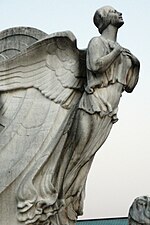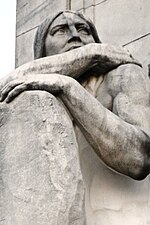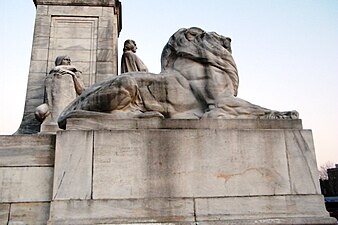Columbus Fountain
| Columbus Fountain | |
|---|---|
 | |
| Artist | Lorado Taft |
| Year | 1912 |
| Type | Marble |
| Dimensions | 14 m × 20 m × 13 m (45 ft × 66 ft × 44 ft) |
| Condition | Inoperable static display |
Union Station Plaza and Columbus Fountain | |
| NRHP reference No. | 80004523 [1] |
| Added to NRHP | April 09, 1980 |
| Location | Washington, D.C., United States |
| 38°53′47.04″N 77°0′23.76″W / 38.8964000°N 77.0066000°W | |
| Owner | National Park Service |
Columbus Fountain is a public artwork by American sculptor Lorado Taft, located at Union Station in Washington, D.C., United States. A centerpiece of Columbus Circle, Columbus Fountain serves as a tribute to the explorer Christopher Columbus.[2]
Description
Columbus Fountain is a semicircular double-basin fountain with a shaft (h. 45 ft.) in the center. The front of the shaft bears a full-length portrait of Christopher Columbus (approx. h. 15 ft.) wearing a mantle, staring forward with his hands folded in front of him. Beneath him is a ship prow that features a winged figurehead that represents the observation of discovery. A globe, representing the Western hemisphere, is on top of the shaft with four eagles on each corner connected by garland. The left and right sides of the shaft have two male figures decorating them. The right side figure is an elderly man, representing the Old World, and on the let side is a figure of a Native American, representing the New World. The back of the shaft has a low-relief medallion (approx. d. 3 ft.) with images of Ferdinand & Isabella. Two lions (approx. h. 5 ft.), placed away from the base, guard the left and right side of the fountain.
The back of the shaft is inscribed:
- TO
- THE MEMORY OF
- CHRISTOPHER COLUMBUS
- WHOSE HIGH FAITH
- AND
- INDOMITABLE COURAGE
- GAVE TO MANKIND
- A NEW WORLD
- BORN MCDXXXVI
- DIED MDIV
The fountain sits in the center of the Columbus traffic circle in front of Union Station.[2][3]
Designing the fountain
The fountain, which was co-created by Taft and architect Daniel Burnham, was influenced by a fountain designed by Frederick MacMonnies that was displayed at the World's Columbian Exposition in Chicago in 1893. This work depicted a figure of Columbia sitting on a ship with a figure of Fame standing on a ship prow holding a trumpet and a representational figure of Time dominating the stern.[2][3]
Acquisition
Lobbying began in 1906 for the sculpture by the Knights of Columbus and the US Congress approved $100,000 for the sculpture on March 4, 1907, along with the city, who also donated funds for the creation of the work. In May 1907 a commission was formed for the memorial fountain headed by prominent members of the Senate and William Howard Taft, who was Secretary of War at the time and served as committee chairman. Upon agreeing on the location for the fountain, a call for designs was requested by artists from America, Italy and Spain. The reason for the three countries stemmed from the committee idea that "if it should be from the hand of an American, the land which Columbus gave to the world; from an Italian, the land which gave Columbus to the world, or from Spain, the land which made Columbus's achievement possible." [4]
Twenty sculptors submitted proposals for the fountain including: Henri Cronier, Philip Martiny, Charles Keck, Augustus Lukeman, Alfred Sauder, Henry Hering, Charles J. Pike, Pierre Feitu, Leo Lentelli, John C. Hardy, John K. Daniels, Hans Schuler, Giuseppi Donato, J. Otto Schweizer, V.R. Hoxie, Augustin Querol, Louis Weingartner and Taft.[4]
Architect Edward Wilmann of Burnham's architectural firm was put in charge of the construction of the piece.[2]
Installation and dedication
On October 31, 1911 construction, which was supervised by A. W. Taylor of J.C. Robinson & Son, began and the piece was installed from March–June 1912.[2]
The Knights of Columbus headed up the dedication ceremony on June 8, 1912. It was estimated that at least 150,000 people were expected to attend the opening. Congress supplied an extra $6,000 for expanded police security, with the Knights requesting at least 500 officers to participate. $10,000 was contributed by the Knights of Columbus for the event decorations, supplies and general planning.
The Knights planned an entire weekend around the dedication ceremony. Friday, June 7, Knights of Columbus from around the world gathered in Washington, first visiting the tomb of George Washington at Mount Vernon, following by an evening reception in Washington.
The day of the reception, Saturday, a parade was planned to feature between 80,000 to 85,000 participants. General Robert K. Evans, Chief of Military Affairs, served as the parade marshal, riding at the front of 15,000 troops from the Navy and Marines. Knights of Columbus representatives, upwards of 50,000, encompassed the second part of the parade. Parade floats followed behind, each drawn by six horses, followed by people dressed in "knightly costumes". Float themes included "The Departure of Columbus," and "Columbus Soliciting Aid from the Court of Spain," followed by 2,000 cars. President Taft overlooked the parade from the stands.
The unveiling of the art work was presided over by then Secretary of State Philander Knox, with invocation given by Father Thomas Shahan, the Rector of the Catholic University of America. Other notable participants included Chief Justice Victor J. Dowling, Italian Ambassador Cusania Confalonieri, James McCreary, Archbishop Bonzano, and other Catholic church notables. President Taft also provided the formal address. Saturday evening a ball was held at the convention center, again attended by President Taft and other prominent figures.
Sunday, June 9, Spanish war veterans assembled at the Washington Monument for mass with Cardinal James Gibbons and Archbishop Bonzano. An estimated 10,000 people were believed to attend the mass. A final evening event was held at the convention center featuring the US Marine Corps Band.[4]
Columbus Day
Every year Columbus Day celebrations are held featuring the US Marine Corps Band and a wreath laying ceremony.
Condition and conservation
It was added to the National Register of Historic Places, on March 7, 1968.[5]
In October 1992 the memorial was spray painted with graffiti and the National Park Service removed it with surface cleaners. In March 1994 the work was surveyed by the Save Outdoor Sculpture! program and was described as needing treatment.[2]
The fountain has appeared severely deteriorated for many years and its plumbing is not believed to be in operable condition.
Gallery
-
1919
-
The fountain in the early-mid 20th century.
-
The front of the fountain.
-
Detail of the "elderly" figure.
-
Detail of the figurehead.
-
Detail of the Native American figure.
-
Detail of one of the two lions that flank the fountain.
See also
References
- ^ https://npgallery.nps.gov/NRHP/GetAsset/NRHP/80004523_text
- ^ a b c d e f Smithsonian (1994). "Columbus Memorial, (sculpture)". Save Outdoor Sculpture. Smithsonian. Retrieved 10 Feb 2011.
- ^ a b Goode, John Washington Sculpture. The Johns Hopkins University Press, 2008, p. 14.
- ^ a b c "Splendid Columbus Memorial to be Unveiled in Washington". New York Times. June 2, 1912. Retrieved 11 Feb 2011.
- ^ Nancy Taylor and Barry Macintosh, 1978, NRHP Nomination Form - Union Station (including Union Station Plaza and Columbus Fountain
Further reading
- Carrier, Thomas J. Washington, DC: A Historic Walking Tour. Arcadia Publishing, 1999. ISBN 0-7385-0049-6.
- Ciesielski, Gregory R. Christopher Columbus Memorial Fountain. Discovery! Journal of the Christopher Columbus Philatelic Society, Vol. 18, No. 2, April 2000.
- Highsmith, Carol & Ted Landphair. Union Station : A Decorative History of Washington's Grand Terminal. Chelsea Pub, 1988. ISBN 0-9620877-0-X.
- Moeller, G. Martin. AIA Guide to the Architecture of Washington, D.C. The Johns Hopkins University Press, 2006. ISBN 0-8018-8468-3.
External links
- Christopher Columbus Statues and Monuments
- Columbus Fountain on dcMemorials
- Columbus Monument
- Delaware Avenue & Columbus Circle, NE Historical Information from The Historical Marker Database
- National Columbus Celebration Association
- National Register of Historic Places Inventory-Nomination Form for Union Station & Columbus Fountain, 1979
- Religious figures among those immortalized in Washington's statuary - including many works dedicated by the Knights of Columbus
- Revisiting the Christopher Columbus Memorial Fountain by Ben Schuman Stoler
- Fountains in Washington, D.C.
- Statues in Washington, D.C.
- Capitol Hill
- Monuments and memorials on the National Register of Historic Places in Washington, D.C.
- Artworks in the collection of the National Park Service
- Marble sculptures in Washington, D.C.
- Sculptures by Lorado Taft
- 1912 sculptures
- Christopher Columbus
- Knights of Columbus
- Native Americans in art
- Artworks surveyed by Save Outdoor Sculpture! in Washington, D.C.
- 1912 establishments in Washington, D.C.









